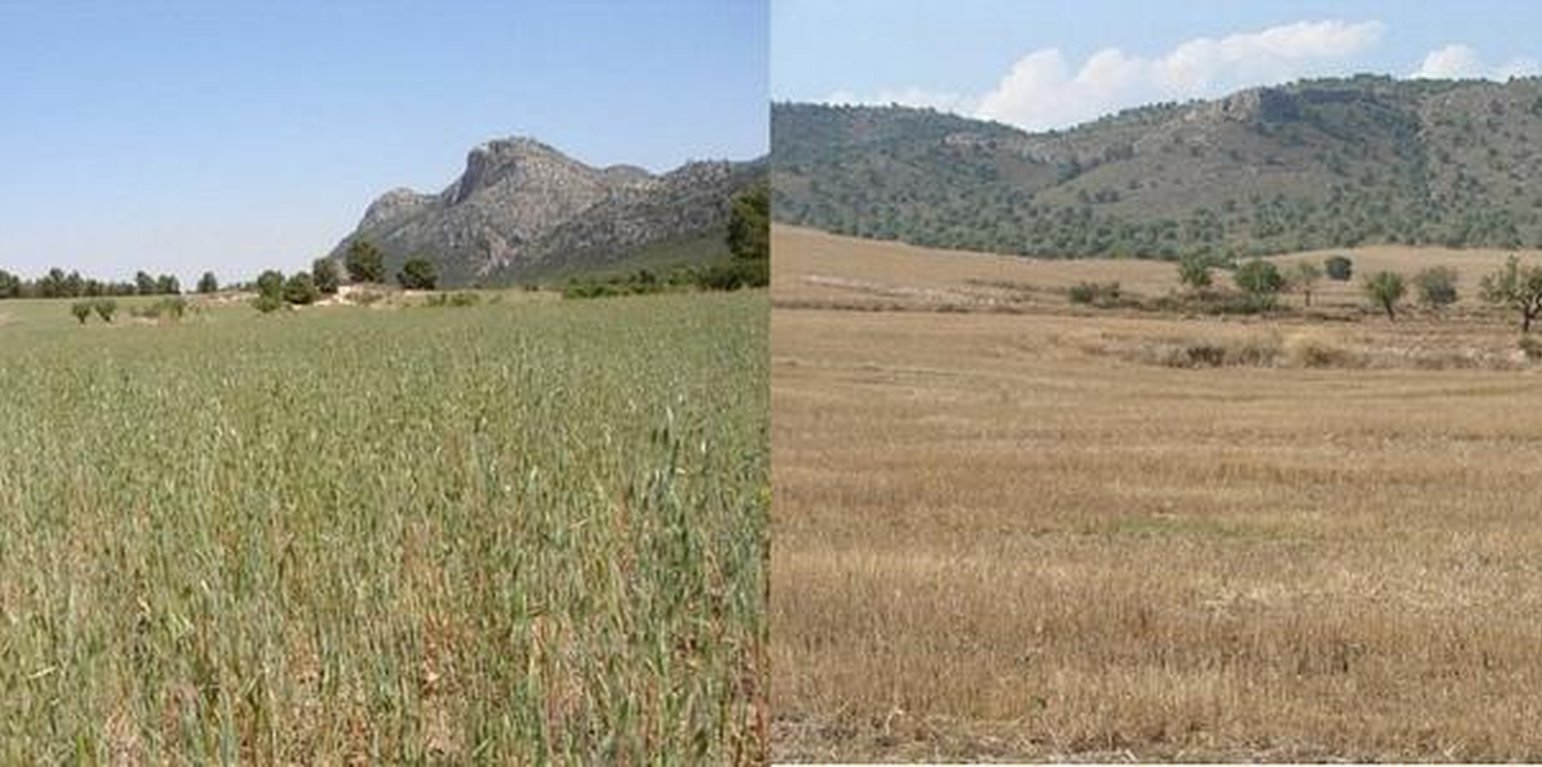Reduced contour tillage of cereals in semi-arid environments
(สเปน)
Labranza reducida de cereal en contra de la pendiente en ambientes semi-áridos (ES)
คำอธิบาย
Reduced contour tillage in a rotational system of winter cereals and fallow land.
This technology is a type of conservation tillage with minimal economic effort and is adapted to semi-arid conditions. Tillage is reduced to a maximum of three times surface tillage (20-30cm) in two years with a disc- or a chisel-plough. The disc-plough is only used where there is a dense weed or crop residue cover. The disc-plough breaks-up the soil top layer better than the chisel-plough, while the chisel tends to plough slightly deeper (~30cm) than the disc-plough (~20cm). The advantage of the chisel-plough is that it leaves a higher surface roughness and is less destructive to soil aggregates. Under conventional tillage, fields are ploughed up to five times every two years, once with a mouldboard plough. In both systems, cereals are cropped in a rotational system with fallow land. Cereals are sown in autumn (October) and harvested in June followed by a fallow year. Under reduced tillage the crop residues are left on the field throughout the autumn and winter periods. This provides increased protection against soil erosion. Tillage is performed on fallow land in early spring (March-April) to prepare the land for sowing in October. With conventional tillage, fields are ploughed with a mouldboard plough in autumn. Traditional sowing machinery can be used so no investments are needed in specialised equipment. Tillage is performed parallel to the contour lines to prevent rill and gully formation. No herbicides are required since annual weeds are mixed with the upper soil layer during ploughing. Owing to increased organic matter content and a better infiltration capacity, soil water retention capacity, soil humidity and crop yields will increase within 3-5 years after implementation.
The aim of this technology is to increase the soil organic matter content by retaining it in soil aggregates and to reduce soil erosion by water and tillage. The higher infiltration capacity and better surface cover with crop residues in autumn and winter protects the soil against water erosion, reducing soil erosion by over 50% and runoff by 30%. In addition, the better organic matter content increases overall soil quality in terms of soil structure and water holding capacity. Compared to traditional multiple tillage operations with a mouldboard plough, under reduced tillage, tillage erosion is reduced by having fewer tillage operations, but also through tillage of fallow land resulting in lower tillage erosion rates than secondary tillage operations of already loosened soil. Fuel use by tractors is decreased, leading to a reduction of 40% in production costs and reduced CO2 emissions. Some studies showed that in first 2-3 years after implementation, the soil can be denser and have a lower infiltration capacity than under traditional tillage regimes. Yet, when the organic matter content and soil structure have increased, infiltration rates are higher than under traditional ploughing and result in increased soil water content and crop yields.
The technology is applied on loamy soils with a calcareous substrate, of shallow to medium depth, and slopes are gentle to moderate (5-15%). The climate is semi-arid with a mean annual rainfall of around 300 mm. Droughts, centred in summer commonly last for more than 4-5 months. Annual potential evapotranspiration rates greater than 1000 mm are common. The production system is highly mechanised and market oriented but depends strongly on agricultural subsidies.
สถานที่
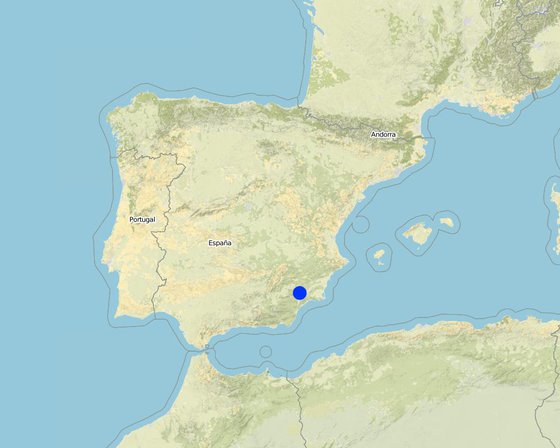
สถานที่: Guadalentin catchment, Murcia, สเปน
ตำนวนการวิเคราะห์เทคโนโลยี:
ตำแหน่งทางภูมิศาสตร์ของสถานที่ที่ถูกเลือ
การเผยแพร่ของเทคโนโลยี: กระจายไปอย่างสม่ำเสมอในพื้นที่ (approx. 10-100 ตร.กม.)
In a permanently protected area?:
วันที่ในการดำเนินการ: น้อยกว่า 10 ปี (ไม่นานนี้)
ประเภทของการแนะนำ
-
ด้วยการริเริ่มของผู้ใช้ที่ดินเอง
-
เป็นส่วนหนึ่งของระบบแบบดั้งเดิมที่ทำก้นอยู่ (> 50 ปี)
-
ในช่วงการทดลองหรือการทำวิจัย
-
ทางโครงการหรือจากภายนอก
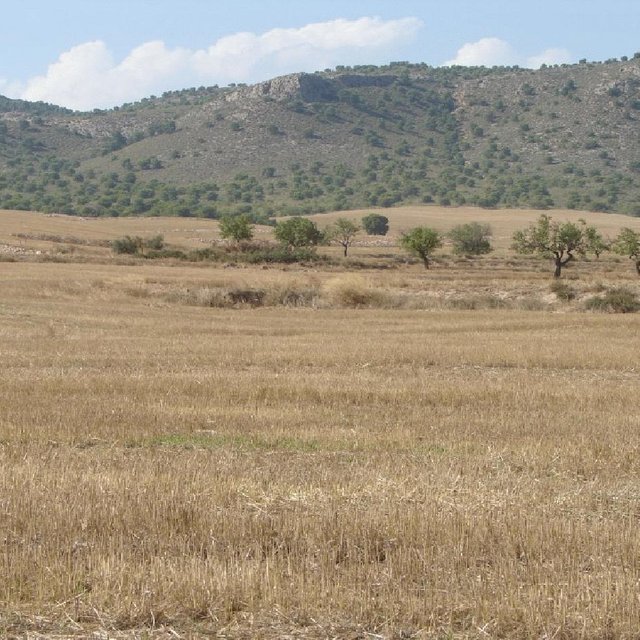
Crop residue in August of cereals that were harvested around May/June. This field will remain like this until March/April next year when it will be ploughed for sowing in autumn (Joris de Vente)
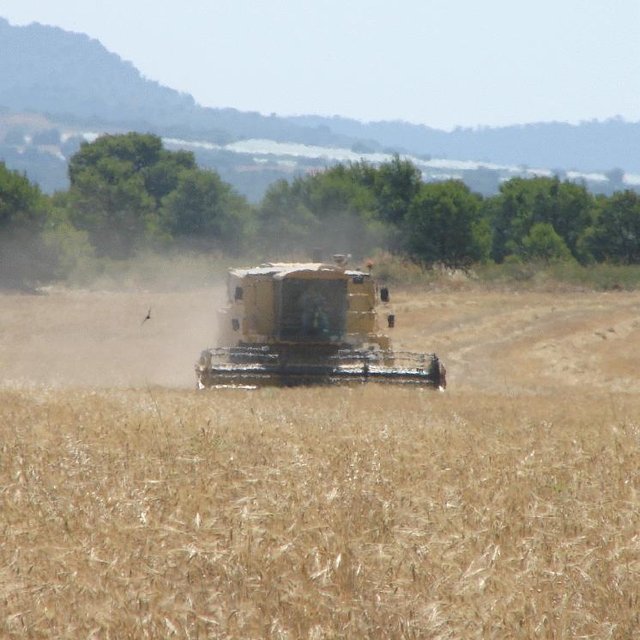
Cereal harvest in June. (Joris de Vente)
จุดประสงค์หลัก
-
ปรับปรุงการผลิตให้ดีขึ้น
-
ลด ป้องกัน ฟื้นฟู การเสื่อมโทรมของที่ดิน
-
อนุรักษ์ระบบนิเวศน์
-
ป้องกันพื้นที่ลุ่มน้ำ/บริเวณท้ายน้ำ โดยร่วมกับเทคโนโลยีอื่นๆ
-
รักษาสภาพหรือปรับปรุงความหลากหลายทางชีวภาพ
-
ลดความเสี่ยงของภัยพิบัติ
-
ปรับตัวเข้ากับการเปลี่ยนแปลงภูมิอากาศของโลก สภาพภูมิอากาศที่รุนแรงและผลกระทบ
-
ชะลอการเปลี่ยนแปลงภูมิอากาศของโลกและผลกระทบ
-
สร้างผลกระทบทางด้านเศรษฐกิจที่เป็นประโยชน์
-
สร้างผลกระทบทางด้านสังคมที่เป็นประโยชน์
การใช้ที่ดิน
-
พื้นที่ปลูกพืช
- การปลูกพืชล้มลุกอายุปีเดียว
จำนวนของฤดูเพาะปลูกต่อปี: 1
การใช้น้ำ
-
จากน้ำฝน
-
น้ำฝนร่วมกับการชลประทาน
-
การชลประทานแบบเต็มรูปแบบ
ความมุ่งหมายที่เกี่ยวข้องกับการเสื่อมโทรมของที่ดิน
-
ป้องกันความเสื่อมโทรมของที่ดิน
-
ลดความเสื่อมโทรมของดิน
-
ฟื้นฟูบำบัดที่ดินที่เสื่อมโทรมลงอย่างมาก
-
ปรับตัวกับสภาพความเสื่อมโทรมของที่ดิน
-
ไม่สามารถใช้ได้
ที่อยู่ของการเสื่อมโทรม
-
การกัดกร่อนของดินโดยน้ำ - Wt (Loss of topsoil): การสูญเสียดินชั้นบนหรือการกัดกร่อนที่ผิวดิน , Wg (Gully erosion): การกัดกร่อนแบบร่องธารหรือการทำให้เกิดร่องน้ำเซาะ
-
การเสื่อมโทรมของดินทางด้านกายภาพ - Pk (Slaking and crusting): การอุดตันของช่องว่างในดินหรือรูพรุน
-
การเสื่อมโทรมของน้ำ - Ha (Aridification): การเกิดความแห้งแล้ง
มาตรการ SLM
-
มาตรการจัดการพืช - A1: พืช/สิ่งปกคลุมดิน, A3: การรักษาหน้าดิน, A4: การรักษาดินชั้นล่าง
แบบแปลนทางเทคนิค
ข้อมูลจำเพาะด้านเทคนิค
Photo of the disc-plough used for superficial ploughing (~20cm depth) where there is a large amount of crop residue and/or perennial vegetation. Bottom: Chisel-plough
Technical knowledge required for field staff / advisors: moderate. Technical knowledge required for land users: moderate.
Main technical functions: control of raindrop splash, control of dispersed runoff: retain / trap, control of dispersed runoff: impede / retard, control of concentrated runoff: impede / retard, improvement of ground cover, improvement of surface structure (crusting, sealing), improvement of topsoil structure (compaction), improvement of subsoil structure (hardpan), increase in organic matter, increase of infiltration, increase / maintain water stored in soil. Secondary technical functions: increase of surface roughness, increase in nutrient availability (supply, recycling,…)
Rotations / fallows: cereals are followed by 1-2 years of fallow
Breaking crust / sealed surface / compacted topsoi: Disc-plough or chisel-plough
Minimum tillage: Disc-plough or chisel-plough
Non-inversion tillage: Disc-plough or chisel-plough
Contour tillage: Disc-plough or chisel-plough
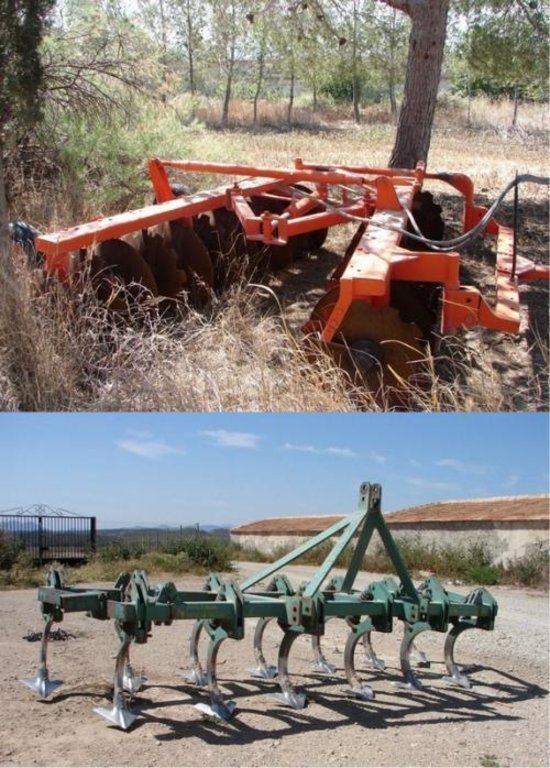
Author: Joris de Vente
การจัดตั้งและการบำรุงรักษา: กิจกรรม ปัจจัยและค่าใช้จ่าย
การคำนวนต้นทุนและค่าใช้จ่าย
- ค่าใช้จ่ายถูกคำนวน
- สกุลเงินที่ใช้คำนวณค่าใช้จ่าย Euro
- อัตราแลกเปลี่ยน (ไปเป็นดอลลาร์สหรัฐ) คือ 1 ดอลลาร์สหรัฐ = 0.63 Euro
- ค่าจ้างเฉลี่ยในการจ้างแรงงานต่อวันคือ 79.00
ปัจจัยที่สำคัญที่สุดที่มีผลต่อค่าใช้จ่าย
Fuel price is the most determinate factor affecting the costs.
กิจกรรมเพื่อการจัดตั้ง
n.a.
ปัจจัยและค่าใช้จ่ายของการจัดตั้ง
| ปัจจัยนำเข้า |
หน่วย |
ปริมาณ |
ค่าใช้จ่ายต่อหน่วย (Euro) |
ค่าใช้จ่ายทั้งหมดต่อปัจจัยนำเข้า (Euro) |
%ของค่าใช้จ่ายที่ก่อให้เกิดขึ้นโดยผู้ใช้ที่ดิน |
|
แรงงาน
|
| Disc plough |
piece |
1.0 |
397.0 |
397.0 |
100.0 |
| ค่าใช้จ่ายทั้งหมดของการจัดตั้งเทคโนโลยี |
397.0 |
|
| Total costs for establishment of the Technology in USD |
630.16 |
|
กิจกรรมสำหรับการบำรุงรักษา
-
Tillage with disc-plough (ช่วงระยะเวลา/ความถี่: Before seeding once every 2 years in a rotational fallow system)
ปัจจัยและค่าใช้จ่ายของการบำรุงรักษา
| ปัจจัยนำเข้า |
หน่วย |
ปริมาณ |
ค่าใช้จ่ายต่อหน่วย (Euro) |
ค่าใช้จ่ายทั้งหมดต่อปัจจัยนำเข้า (Euro) |
%ของค่าใช้จ่ายที่ก่อให้เกิดขึ้นโดยผู้ใช้ที่ดิน |
|
แรงงาน
|
| Labour |
|
1.0 |
12.0 |
12.0 |
100.0 |
|
อุปกรณ์
|
| Machine hours |
|
1.0 |
50.0 |
50.0 |
99.0 |
| ค่าใช้จ่ายทั้งหมดของการบำรุงรักษาสภาพเทคโนโลยี |
62.0 |
|
| Total costs for maintenance of the Technology in USD |
98.41 |
|
สิ่งแวดล้อมทางธรรมชาติ
ปริมาณน้ำฝนเฉลี่ยรายปี
-
< 250 ม.ม.
-
251-500 ม.ม.
-
501-750 ม.ม.
-
751-1,000 ม.ม.
-
1,001-1,500 ม.ม.
-
1,501-2,000 ม.ม.
-
2,001-3,000 ม.ม.
-
3,001-4,000 ม.ม.
-
> 4,000 ม.ม.
เขตภูมิอากาศเกษตร
-
ชื้น
-
กึ่งชุ่มชื้น
-
กึ่งแห้งแล้ง
-
แห้งแล้ง
ข้อมูลจำเพาะเรื่องภูมิอากาศ
Dry period in summer during 3-4 months (June – August/September)
Thermal climate class: subtropics. The higher parts are generally somewhat colder
ความชัน
-
ราบเรียบ (0-2%)
-
ลาดที่ไม่ชัน (3-5%)
-
ปานกลาง (6-10%)
-
เป็นลูกคลื่น (11-15%)
-
เป็นเนิน (16-30%)
-
ชัน (31-60%)
-
ชันมาก (>60%)
ภูมิลักษณ์
-
ที่ราบสูง/ที่ราบ
-
สันเขา
-
ไหล่เขา
-
ไหล่เนินเขา
-
ตีนเนิน
-
หุบเขา
ความสูง
-
0-100 เมตร
-
101-500 เมตร
-
501-1,000 เมตร
-
1,001-1,500 เมตร
-
1,501-2,000 เมตร
-
2,001-2,500 เมตร
-
2,501-3,000 เมตร
-
3,001-4,000 เมตร
-
> 4,000 เมตร
เทคโนโลยีถูกประยุกต์ใช้ใน
-
บริเวณสันเขา (convex situations)
-
บริเวณแอ่งบนที่ราบ (concave situations)
-
ไม่เกี่ยวข้อง
ความลึกของดิน
-
ตื้นมาก (0-20 ซ.ม.)
-
ตื้น (21-50 ซ.ม.)
-
ลึกปานกลาง (51-80 ซ.ม.)
-
ลึก (81-120 ซ.ม.)
-
ลึกมาก (>120 ซ.ม.)
เนื้อดิน (ดินชั้นบน)
-
หยาบ/เบา (ดินทราย)
-
ปานกลาง (ดินร่วน ทรายแป้ง)
-
ละเอียด/หนัก (ดินเหนียว)
เนื้อดิน (> 20 ซม. ต่ำกว่าพื้นผิว)
-
หยาบ/เบา (ดินทราย)
-
ปานกลาง (ดินร่วน ทรายแป้ง)
-
ละเอียด/หนัก (ดินเหนียว)
สารอินทรียวัตถุในดิน
-
สูง (>3%)
-
ปานกลาง (1-3%)
-
ต่ำ (<1%)
น้ำบาดาล
-
ที่ผิวดิน
-
<5 เมตร
-
5-50 เมตร
-
> 50 เมตร
ระดับน้ำบาดาลที่ผิวดิน
-
เกินพอ
-
ดี
-
ปานกลาง
-
ไม่ดีหรือไม่มีเลย
คุณภาพน้ำ (ยังไม่ได้รับการบำบัด)
-
เป็นน้ำเพื่อการดื่มที่ดี
-
เป็นน้ำเพื่อการดื่มที่ไม่ดี (จำเป็นต้องได้รับการบำบัด)
-
เป็นน้ำใช้เพื่อการเกษตรเท่านั้น (การชลประทาน)
-
ใช้ประโยชน์ไม่ได้
Water quality refers to:
ความเค็มของน้ำเป็นปัญหาหรือไม่?
การเกิดน้ำท่วม
ความหลากหลายทางชนิดพันธุ์
ความหลากหลายของแหล่งที่อยู่
ลักษณะเฉพาะของผู้ใช้ที่ดินที่ประยุกต์ใช้เทคโนโลยี
เป้าหมายทางการตลาด
-
เพื่อการยังชีพ (หาเลี้ยงตนเอง)
-
mixed (subsistence/ commercial)
-
ทำการค้า/การตลาด
รายได้จากภายนอกฟาร์ม
-
< 10% ของรายได้ทั้งหมด
-
10-50% ของรายได้ทั้งหมด
-
> 50% ของรายได้ทั้งหมด
ระดับของความมั่งคั่งโดยเปรียบเทียบ
-
ยากจนมาก
-
จน
-
พอมีพอกิน
-
รวย
-
รวยมาก
ระดับของการใช้เครื่องจักรกล
-
งานที่ใช้แรงกาย
-
การใช้กำลังจากสัตว์
-
การใช้เครื่องจักรหรือเครื่องยนต์
อยู่กับที่หรือเร่ร่อน
-
อยู่กับที่
-
กึ่งเร่ร่อน
-
เร่ร่อน
เป็นรายบุคคลหรือกลุ่ม
-
เป็นรายบุคคล/ครัวเรือน
-
กลุ่ม/ชุมชน
-
สหกรณ์
-
ลูกจ้าง (บริษัท รัฐบาล)
อายุ
-
เด็ก
-
ผู้เยาว์
-
วัยกลางคน
-
ผู้สูงอายุ
พื้นที่ที่ใช้ต่อครัวเรือน
-
< 0.5 เฮกตาร์
-
0.5-1 เฮกตาร์
-
1-2 เฮกตาร์
-
2-5 เฮกตาร์
-
5-15 เฮกตาร์
-
15-50 เฮกตาร์
-
50-100 เฮกตาร์
-
100-500 เฮกตาร์
-
500-1,000 เฮกตาร์
-
1,000-10,000 เฮกตาร์
-
>10,000 เฮกตาร์
ขนาด
-
ขนาดเล็ก
-
ขนาดกลาง
-
ขนาดใหญ่
กรรมสิทธิ์ในที่ดิน
-
รัฐ
-
บริษัท
-
เป็นแบบชุมชนหรือหมู่บ้าน
-
กลุ่ม
-
รายบุคคล ไม่ได้รับสิทธิครอบครอง
-
รายบุคคล ได้รับสิทธิครอบครอง
สิทธิในการใช้ที่ดิน
-
เข้าถึงได้แบบเปิด (ไม่ได้จัดระเบียบ)
-
เกี่ยวกับชุมชน (ถูกจัดระเบียบ)
-
เช่า
-
รายบุคคล
สิทธิในการใช้น้ำ
-
เข้าถึงได้แบบเปิด (ไม่ได้จัดระเบียบ)
-
เกี่ยวกับชุมชน (ถูกจัดระเบียบ)
-
เช่า
-
รายบุคคล
เข้าถึงการบริการและโครงสร้างพื้นฐาน
ความช่วยเหลือทางด้านเทคนิค
การจ้างงาน (เช่น ภายนอกฟาร์ม)
ผลกระทบ
ผลกระทบทางด้านเศรษฐกิจและสังคม
การผลิตพืชผล
Depending on local conditions yield may be the same or increase slightly. Sometimes in first year of implementation crop production is slightly reduced.
ค่าใช่จ่ายของปัจจัยการผลิตทางการเกษตร
Possible investment in a Disc-plough during first years
รายได้จากฟาร์ม
Depends on crop yield. Gasoline use is decreasing.
ภาระงาน
Reduced labour: Less ploughing required.
ผลกระทบด้านสังคมและวัฒนธรรม
ผลกระทบด้านนิเวศวิทยา
การเก็บเกี่ยวหรือการกักเก็บน้ำ (น้ำค้างหิมะ)
On the long term higher infiltration capacity of the soil
การเกิดแผ่นแข็งที่ผิวดิน /การเกิดชั้นดาน
การหมุนเวียนและการเติมของธาตุอาหาร
การปล่อยคาร์บอนและก๊าซเรือนกระจก
ผลกระทบนอกพื้นที่ดำเนินการ
น้ำท่วมพื้นที่ท้ายน้ำ (ที่ไม่เป็นที่ต้องการ)
การทับถมของดินตะกอนพื้นที่ท้ายน้ำ
ความเสียหายต่อพื้นที่เพาะปลูกของเพื่อนบ้าน
ความเสียหายต่อโครงสร้างพื้นฐานของรัฐหรือของเอกชน
รายได้และค่าใช้จ่าย
ผลประโยชน์ที่ได้รับเปรียบเทียบกับค่าใช้จ่าย
ผลตอบแทนระยะสั้น
ด้านลบอย่างมาก
ด้านบวกอย่างมาก
ผลตอบแทนระยะยาว
ด้านลบอย่างมาก
ด้านบวกอย่างมาก
ผลประโยชน์ที่ได้รับเปรียบเทียบกับค่าใช้จ่ายในการบำรุงรักษา
ผลตอบแทนระยะสั้น
ด้านลบอย่างมาก
ด้านบวกอย่างมาก
ผลตอบแทนระยะยาว
ด้านลบอย่างมาก
ด้านบวกอย่างมาก
การเปลี่ยนแปลงของสภาพภูมิอากาศ
การเปลี่ยนแปลงสภาพภูมิอากาศที่ค่อยเป็นค่อยไป
อุณหภูมิประจำปี เพิ่มขึ้น
สภาพรุนแรงของภูมิอากาศ (ภัยพิบัติ)
ผลลัพธ์ตามมาที่เกี่ยวข้องกับภูมิอากาศอื่น ๆ
การน้อมเอาความรู้และการปรับใช้
เปอร์เซ็นต์ของผู้ใช้ที่ดินในพื้นที่ที่นำเทคโนโลยีไปใช้
-
ครั้งเดียวหรือเป็นการทดลอง
-
1-10%
-
11-50%
-
> 50%
จากทั้งหมดที่ได้รับเทคโนโลยีเข้ามามีจำนวนเท่าใดที่ทำแบบทันที โดยไม่ได้รับการจูงใจด้านวัสดุหรือการเงินใดๆ?
-
0-10%
-
11-50%
-
51-90%
-
91-100%
เทคโนโลยีได้รับการปรับเปลี่ยนเร็วๆ นี้เพื่อให้ปรับตัวเข้ากับสภาพที่กำลังเปลี่ยนแปลงหรือไม่?
สภาพที่กำลังเปลี่ยนแปลงอันไหน?
-
การเปลี่ยนแปลงแบบค่อยเป็นค่อยไปและสภาพรุนแรงของภูมิอากาศ
-
การเปลี่ยนแปลงของตลาด
-
การมีแรงงานไว้ให้ใช้ (เนื่องจากการอพยพย้ายถิ่นฐาน)
บทสรุปหรือบทเรียนที่ได้รับ
จุดแข็ง: มุมมองของผู้ใช้ที่ดิน
-
The technology is low cost and even generates more farm income due to lower fuel use. The increased soil cover through winter and the contour ploughing have a notable positive effect on rill and gully formation in the fields. (How to sustain: The tillage between two fallow periods might be avoided to further reduce fuel use and maintain surface cover intact. However, in order to apply for subsidies for agricultural extensification, farmers are obliged to plough fallow land once a year in order to eliminate weeds.)
จุดแข็ง: ทัศนคติของผู้รวบรวมหรือวิทยากรคนอื่นๆ
-
This is a low-cost technology that requires limited initial investments in equipment and potentially results in a slightly increased farm income, as well as a decrease in land degradation and an increase in soil quality and water-holding capacity. (How to sustain: In some higher areas with sufficient rainfall, the technology might be adapted to conservation tillage with direct sowing, reducing the tillage operations even more. However, this implies an important investment in machinery and a high level of organisation at the agricultural cooperation level.)
-
An increased soil surface cover throughout autumn and winter provides a good protection against soil erosion reducing rill and gully formation. (How to sustain: Sometimes a field is left fallow for two consecutive years, but it is still ploughed between them. This ploughing might be avoided as well.)
จุดด้อย/ข้อเสีย/ความเสี่ยง: มุมมองของผู้ใช้ที่ดินแก้ไขปัญหาได้อย่างไร
-
In order to apply for subsidies for cereal cultivation in a rotation system with fallow, farmers are obliged to plough after each fallow period to control weeds, even when two consecutive years of fallow are applied. This is considered unnecessary
It might be worthwhile to test the need for this and look for alternatives without ploughing.
จุดด้อย/ข้อเสีย/ความเสี่ยง: ทัศนคติของผู้รวบรวมหรือวิทยากรคนอื่นๆแก้ไขปัญหาได้อย่างไร
-
The most important weakness of this technology is that it does not significantly improve farm income and so may not be stimulating enough for farmers to apply
Provide information on all the advantages of good soil management that include many costs for society (including floods, reservoir siltation, etc.) and stress the fact that reduced tillage will lead to less work for the same or slightly higher profit.
การอ้างอิง
ผู้ตรวจสอบ
-
Deborah Niggli
-
Alexandra Gavilano
วันที่จัดทำเอกสาร: 15 มกราคม 2011
การอัพเดทล่าสุด: 21 มิถุนายน 2019
วิทยากร
-
Joris De Vente - ผู้เชี่ยวชาญ SLM
-
Ascensión Ibáñez Torres - None
-
Antonio Escamez - ผู้ใช้ที่ดิน
คำอธิบายฉบับเต็มในฐานข้อมูล WOCAT
การจัดทำเอกสารถูกทำโดย
องค์กร
- EEZA-CSIC (EEZA-CSIC) - สเปน
โครงการ
การอ้งอิงหลัก
-
Angás, P., Lampurlanés, J. and Cantero-Martínez, C., 2006. Tillage and N fertilization: Effects on N dynamics and Barley yield under semiarid Mediterranean conditions. Soil and Tillage Research, 87(1): 59-71.: Internet
-
Holland, J.M., 2004. The environmental consequences of adopting conservation tillage in Europe: reviewing the evidence. Agriculture, Ecosystems & Environment, 103(1): 1-25.: Internet
-
Hoogmoed, W.B. and Derpsch, R., 1985. Chisel ploughing as an alternative tillage system in Parana, Brazil. Soil and Tillage Research, 6(1): 53-67.: Internet
-
Josa, R. and Hereter, A., 2005. Effects of tillage systems in dryland farming on near-surface water content during the late winter period. Soil and Tillage Research, 82(2): 173-183.: Internet
-
Lampurlanés, J. and Cantero-Martínez, C., 2006. Hydraulic conductivity, residue cover and soil surface roughness under different tillage systems in semiarid conditions. Soil and Tillage Research, 85(1-2): 13-26.: Internet
-
Lampurlanés, J., Angás, P. and Cantero-Martínez, C. 2002. Tillage effects on water storage during fallow, and on barley root growth and yield in two contrasting soils of the semi-arid Segarra region in Spain. Soil and Tillage Research, 65(2): 207-220: Internet
-
López-Fando, C., Dorado, J. and Pardo, M.T., 2007. Effects of zone-tillage in rotation with no-tillage on soil properties and crop yields in a semi-arid soil from central Spain. Soil and Tillage Research, 95(1-2): 266-276.: Internet
-
Martin-Rueda, I., Muñoz-Guerra, L.M., Yunta, F., Esteban, E., Tenorio, J.L. and Lucena, J.J., 2007. Tillage and crop rotation effects on barley yield and soil nutrients on a Calciortidic Haploxeralf. Soil and Tillage Research, 92(1-2): 1-9: Internet
-
Ozpinar, S., 2006. Effects of tillage systems on weed population and economics for winter wheat production under the Mediterranean dryland conditions. Soil and Tillage Research, 87(1): 1-8.: Internet
-
Van Muysen, W., Govers, G., Van Oost, K. and Van Rompaey, A., 2000. The effect of tillage depth, tillage speed and soil condition on chisel tillage erosivity. Journal of Soil and Water Conservation(355-364).: Internet
-
Van Muysen, W., Govers, G., Bergkamp, G., Roxo, M. and Poesen, J., 1999. Measurement and modelling of the effects of initial soil conditions and slope gradient on soil translocation by tillage1. Soil and Tillage Research, 51(3-4): 303-316: Internet
-
Van Oost, K., Govers, G., De Alba, S. and Quine, T.A., 2006. Tillage erosion: a review of controlling factors and implications for soil quality. Progress in Physical Geography, 30(4): 443-466.: Internet
-
CARM 2008. Programa de Desarrollo Rural de la Región de Murcia 2007-2013 Tomo I. 508pp: http://www.carm.es/neweb2/servlet/integra.servlets.ControlPublico?IDCONTENIDO=4689&IDTIPO=100&RASTRO=c431$m1219
-
Poesen, J., van Wesemael, B., Govers, G., Martinez-Fernandez, J., Desmet, P., Vandaele, K., Quine, T. and Degraer, G., 1997. Patterns of rock fragment cover generated by tillage erosion. Geomorphology, 18(3-4): 183-197.: Internet
